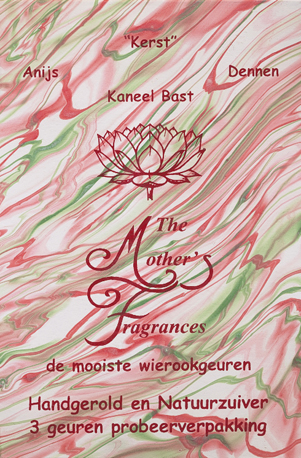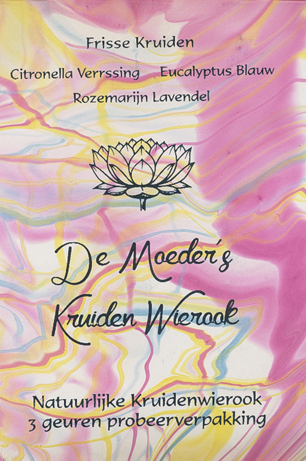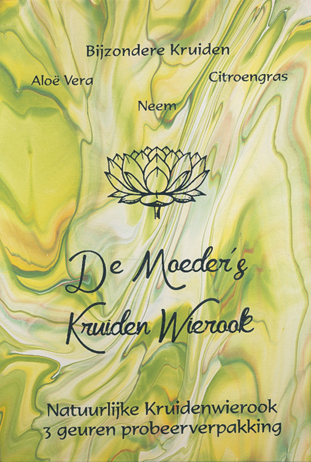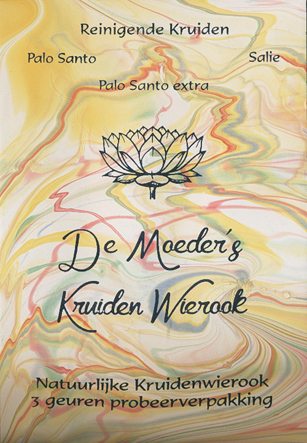The Mother’s – Herbal Line (Trial Packs)
I ordered these four trial packs from the official Mother’s importer in the EU, wierook.nl.
Herbal scents aren’t really my thing, but I was still curious, so I grabbed these so-called “Probeerpakje” (trial packs) instead of buying the bigger sampler straight away. These card-shaped packs each contain 2 mini sticks of three varieties. A trail pack costs 60ct in the Herbal line.
The Herbal line consists only of Dry Masala incense sticks and has a total of 16 varieties. Some are missing here.
For clarity, I as well note the Dutch names [in square brackets] behind the translated names of the varieties, as they appear on the packages; This will also allow you to use the search function of the Wierook web shop.

“Kerst” means Christmas
I find Anise [Anijs] interesting, simply because it is a scent that is not often found in incense sticks.
The scent is quite mild. It’s sweet, green and slightly tart, but not bitter at all. It has a light freshness and a powdery softness. The smell is actually quite close to that of plain anise seeds.
Cinnamon Bark [Kaneel Bast] is the third cinnamon fragrance by Mother’s, alongside Cinnamon from the Golden line and Cinnamon & Spice from the Regular line. I like it the least of the three. Cinnamon Bark seems to be sharper than the others and, overall, just not as rounded. There is also a strange note that I find almost soapy. Furthermore, there is a Cinnamon Leaf [Kaneel Blad] variety in this line, but I haven’t tried it.
Pine [Dennen] is a charcoal Masala and actually belongs to the Regular or Mira line.
They smell very faint at first and later not particularly good. I can’t find anything in it that makes me think of pine; neither the resin, the wood nor the needles. However, they create an association with Christmas. I think when I was little, we had a pack of incense cones that smelled like that, stored in the box of Christmas ornaments.

Fresh Herbs
[Frisse Kruiden]
Surprisingly, I like Citronella Surprise [Citronella Verrssing] much better than lemongrass. But that’s because in this case, “citronella” seems to mean lemon pelargonium, and not citronella oil extracted from a lemongrass, which I can’t stand. (In English, the lemon pelargonium is known as citronella, and it repels insects just as lemongrass does, which often causes additional confusion.)
Citronella Surprise has a pleasantly lemony-fresh, but also slightly powdery, floral scent, which I find to be very bright and friendly.
There is a second citronella scent in this line, named Citronella Rust at Wierook. In other shop catalogues, the two varieties are called Citronella Ceylon and Citronella Java. The latter simply seems to be a stronger version of the scent. I suspect Surprise corresponds to Java, but I don’t know for sure. Wierook themselves couldn’t tell me either.
(The same applies to the two clove scents in the line, but I didn’t order them.)
Eucalyptus Blue [Eucalyptus Blauw] are once again incense sticks that show me that I don’t hate eucalyptus as much as I always think I do.
At first, they smell very smoky, but soon the scent develops into an interesting, darker, tart-spicy-fresh aroma with a rather dry, woody character. There’s also a softness to the scent profile that curiously made me think of cocoa.
Rosemary Lavender [Rozemarijn Lavender] pleasantly surprised me because I wasn’t expecting much from the scent. I usually find lavender incense boring at best, and rosemary is not an easy ingredient.
The lavender oil that Mother’s use appears not to be the standard lavender oil that I am familiar with. It smells softer and powdery-dry. I also found it difficult to recognize it in others of their creations.
At first, Rosemary Lavender smells slightly sweet, but as it progresses the scent develops into a herbaceous sombre, covered in soft powderiness.
They never completely lose their smoky aroma, but I’m still undecided whether that’s a drawback or a point in their favour.
In addition to this variety, there is also a single-note variety of Rosemary.

Special Herbs
[Bijzondere Kruiden]
With this trial pack, we enter what feels like dangerous waters: A barely fragrant plant that is known for its healing power; a plant used as an insect repellent and – perhaps to compensate – common lemongrass. Exciting!
I’ve seen aloe vera incense sticks from time to time in the form of dipped incense and dismissed them as trendy crap. But these Aloe Vera are Dry Masala.
The smell is peculiar and characteristic. What I had forgotten until now was that there is aloe “resin”. This solid, dark green to black substance is the dried sap from the leaf peel of some aloe plants, but not specifically aloe vera. It smells extremely bitter and aromatic to me, but seems to have a fruity scent to many people. I find this smell in Aloe Vera and I find it surprisingly interesting. There’s something strangely green and moist about it.
I wonder what green tea incense lovers would think of this scent.
Until now, I only knew Neem in the form of pellets, which you mix with potting soil for fertilization and to ward off pests. The smell of it is not exactly unpleasant, but it is very “special” to say the least.
The scent of these Neem incense sticks is very different to that. It has a surprisingly fresh and slightly floral smell that appears almost tangy and fruity. Their sweetness reminds me of pollen. At the same time, they have a strange savoury note, a kind of cooking smell in the background, which irritates me at least a little.
Nevertheless, I find Neem very interesting, and I would like to get to know this scent better than these two mini sticks allow.
Lemongrass [Citroengrass] isn’t really my thing, but it smells natural and not unpleasant. At first, the scent seems relatively fresh and grassy, but at the same time it’s dry and woody. Over time, it becomes tart and shifts towards a darker scent. I think Lemongrass has something of a natural, tart, fresh deodorant.

Cleansing Herbs
[Cleansing Kruiden]
Palo Santo were the first Indian palo santo incense sticks that I tried.
They smell in no way like real palo santo wood (or resin) to me. It is a sharp, pungent wood smoke smell with a tart note, vaguely reminiscent of men’s perfume. For me, many “forest” themed Indian incense sticks smell similar-ish to this.
Palo Santo Extra doesn’t do a much better job of portraying the smell of actual palo santo.
However, I find it more pleasant than Palo Santo and even quite interesting.
It’s likewise slightly pungent, spicy and resinous in a special way, as well as slightly sweet and tart.
The smell triggers a vague sense of déjà vu, but I can’t figure out what it reminds me of.
Sage [Salie] doesn’t smell like sage to me either, neither like the herb nor its essential oil. I asked Wierook which sage is used for these incense sticks. Unfortunately, the answer was very disappointing: “Sage oil is all we know. We personally only care about the fragrance, the smell.”
With Sage, I again find a smell that reminds me of stereotypical men’s perfume scents. Tart, somewhat oakmoss-like and dark.
Interestingly, this makes them similar to the White Sage by Satya; Whatever Indian incense manufacturers use for sage, they at least seem to be consistent about it.
In summary, I would say that this line of herbal scents (the term is very broad) is quite interesting and successful. Some scents surprised me positively, others made me curious to get to know them a little better.
I think this line is particularly interesting for people who are looking for natural, unobtrusive scents that are not primarily based on oils. However, if you are looking for the clear scent experience of (high-quality) charcoal-based incense sticks, you probably won’t have much fun with the Herbal line.
